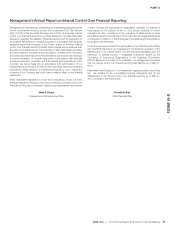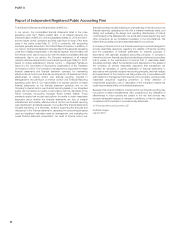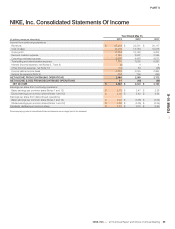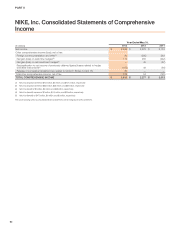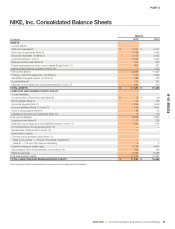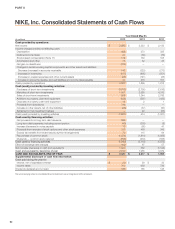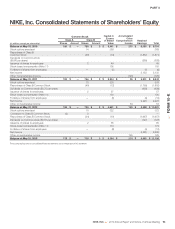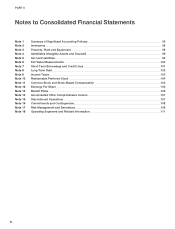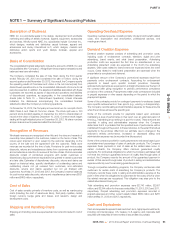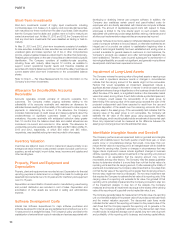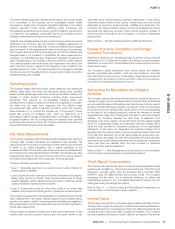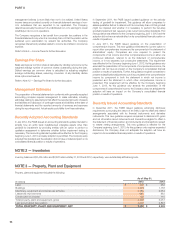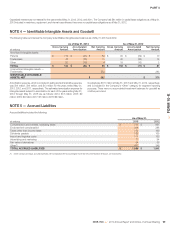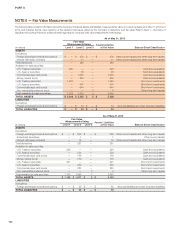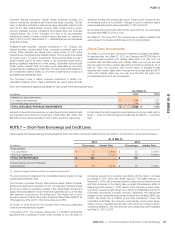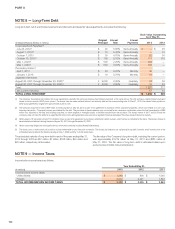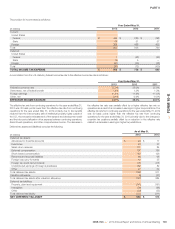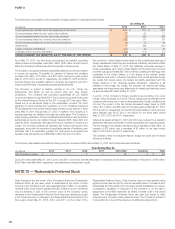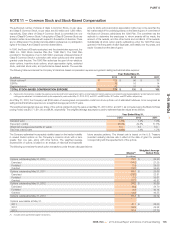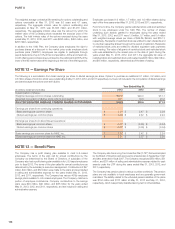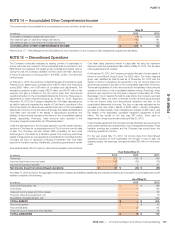Nike 2013 Annual Report Download - page 52
Download and view the complete annual report
Please find page 52 of the 2013 Nike annual report below. You can navigate through the pages in the report by either clicking on the pages listed below, or by using the keyword search tool below to find specific information within the annual report.
PART II
The market valuation approach indicates the fair value of the business based
on a comparison of the reporting unit to comparable publicly traded
companies in similar lines of business. Significant estimates in the market
valuation approach model include identifying similar companies with
comparable business factors such as size, growth, profitability, risk and return
on investment, and assessing comparable revenue and operating income
multiples in estimating the fair value of the reporting unit.
Indefinite-lived intangible assets primarily consist of acquired trade names and
trademarks. The Company may first perform a qualitative assessment to
determine whether it is more likely than not that an indefinite-lived intangible
asset is impaired. If, after assessing the totality of events and circumstances,
the Company determines that it is more likely than not that the indefinite-lived
intangible asset is not impaired, no quantitative fair value measurement is
necessary. If a quantitative fair value measurement calculation is required for
these intangible assets, the Company utilizes the relief-from-royalty method.
This method assumes that trade names and trademarks have value to the
extent that their owner is relieved of the obligation to pay royalties for the
benefits received from them. This method requires the Company to estimate
the future revenue for the related brands, the appropriate royalty rate and the
weighted average cost of capital.
Operating Leases
The Company leases retail store space, certain distribution and warehouse
facilities, office space, and other non-real estate assets under operating
leases. Operating lease agreements may contain rent escalation clauses, rent
holidays or certain landlord incentives, including tenant improvement
allowances. Rent expense for non-cancelable operating leases with
scheduled rent increases or landlord incentives are recognized on a straight-
line basis over the lease term, beginning with the effective lease
commencement date, which is generally the date in which the Company
takes possession of or controls the physical use of the property. Certain
leases also provide for contingent rents, which are determined as a
percentage of sales in excess of specified levels. A contingent rent liability is
recognized together with the corresponding rent expense when specified
levels have been achieved or when the Company determines that achieving
the specified levels during the period is probable.
Fair Value Measurements
The Company measures certain financial assets and liabilities at fair value on a
recurring basis, including derivatives and available-for-sale securities. Fair
value is the price the Company would receive to sell an asset or pay to transfer
a liability in an orderly transaction with a market participant at the
measurement date. The Company uses a three-level hierarchy established by
the Financial Accounting Standards Board (“FASB”) that prioritizes fair value
measurements based on the types of inputs used for the various valuation
techniques (market approach, income approach, and cost approach).
The levels of hierarchy are described below:
•Level 1: Observable inputs such as quoted prices in active markets for
identical assets or liabilities.
•Level 2: Inputs other than quoted prices that are observable for the asset or
liability, either directly or indirectly; these include quoted prices for similar
assets or liabilities in active markets and quoted prices for identical or similar
assets or liabilities in markets that are not active.
•Level 3: Unobservable inputs for which there is little or no market data
available, which require the reporting entity to develop its own assumptions.
The Company’s assessment of the significance of a particular input to the fair
value measurement in its entirety requires judgment and considers factors
specific to the asset or liability. Financial assets and liabilities are classified in
their entirety based on the most conservative level of input that is significant to
the fair value measurement.
Pricing vendors are utilized for certain Level 1 and Level 2 investments. These
vendors either provide a quoted market price in an active market or use
observable inputs without applying significant adjustments in their pricing.
Observable inputs include broker quotes, interest rates and yield curves
observable at commonly quoted intervals, volatilities and credit risks. The
Company’s fair value processes include controls that are designed to ensure
appropriate fair values are recorded. These controls include an analysis of
period-over-period fluctuations and comparison to another independent
pricing vendor.
Refer to Note 6 — Fair Value Measurements for additional information.
Foreign Currency Translation and Foreign
Currency Transactions
Adjustments resulting from translating foreign functional currency financial
statements into U.S. Dollars are included in the foreign currency translation
adjustment, a component of accumulated other comprehensive income in
shareholders’ equity.
The Company’s global subsidiaries have various assets and liabilities,
primarily receivables and payables, which are denominated in currencies
other than their functional currency. These balance sheet items are subject to
remeasurement, the impact of which is recorded in other (income) expense,
net, within the consolidated statements of income.
Accounting for Derivatives and Hedging
Activities
The Company uses derivative financial instruments to reduce its exposure to
changes in foreign currency exchange rates and interest rates. All derivatives
are recorded at fair value on the balance sheet and changes in the fair value of
derivative financial instruments are either recognized in other comprehensive
income (a component of shareholders’ equity), debt or net income depending
on the nature of the underlying exposure, whether the derivative is formally
designated as a hedge, and, if designated, the extent to which the hedge is
effective. The Company classifies the cash flows at settlement from
derivatives in the same category as the cash flows from the related hedged
items. For undesignated hedges and designated cash flow hedges, this is
within the cash provided by operations component of the consolidated
statements of cash flows. For designated net investment hedges, this is
generally within the cash provided or used by investing activities component
of the cash flow statement. As our fair value hedges are receive-fixed, pay-
variable interest rate swaps, the cash flows associated with these derivative
instruments are periodic interest payments while the swaps are outstanding.
These cash flows are reflected within the cash provided by operations
component of the cash flow statement.
RefertoNote17—RiskManagementand Derivatives for more information
on the Company’s risk management program and derivatives.
Stock-Based Compensation
The Company estimates the fair value of options and stock appreciation rights
granted under the NIKE, Inc. 1990 Stock Incentive Plan (the “1990 Plan”) and
employees’ purchase rights under the Employee Stock Purchase Plans
(“ESPPs”) using the Black-Scholes option pricing model. The Company
recognizes this fair value, net of estimated forfeitures, as selling and
administrative expense in the consolidated statements of income over the
vesting period using the straight-line method.
Refer to Note 11 — Common Stock and Stock-Based Compensation for
more information on the Company’s stock programs.
Income Taxes
The Company accounts for income taxes using the asset and liability method.
This approach requires the recognition of deferred tax assets and liabilities for
the expected future tax consequences of temporary differences between the
carrying amounts and the tax basis of assets and liabilities. The Company
records a valuation allowance to reduce deferred tax assets to the amount
NIKE, INC. 2013 Annual Report and Notice of Annual Meeting 97
FORM 10-K


